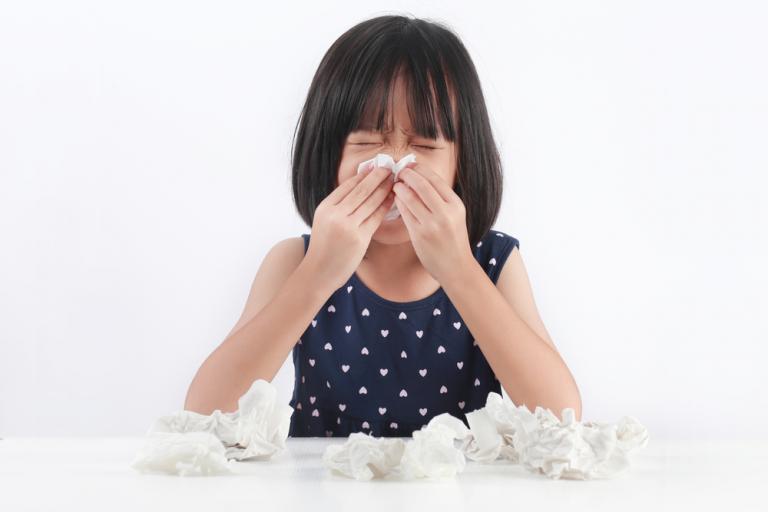Hay Fever in Children
What is Allergic Rhino-conjunctivitis or Allergic Rhinitis?
Allergic rhino-conjunctivitis, which is caused by an allergen, refers to nose and eye allergies that occur at least once a week. When only the nose is affected, it is called allergic rhinitis. It is also known as hay fever, “sinus” or “sensitive nose”.
When only the eyes are affected, it is called allergic conjunctivitis. Incidence of eye and nose allergies in children, are increasing around the world especially in developed countries. The prevalence of allergic rhino-conjunctivitis in Singaporean children up to 2 years old is estimated to be as high as 42%.

What Causes Nose or Eye Allergies in Children?
- Having a family member with asthma, allergic rhino-conjunctivitis or eczema
- House dust mite allergens (they are the most common triggers for allergic rhino-conjunctivitis in Singapore)
- Pollen, which is most common in temperate climates, and animal dander (a combination of dead skin cells and hair or feathers)
- Food is rarely a trigger for isolated eye and nose allergy symptoms
What are the Signs and Symptoms of Allergic Rhino-conjunctivitis or Allergic Rhinitis?
Firstly, there is no such thing as a “normal blocked nose” and this symptom is often ignored/untreated. Children with allergic rhino-conjunctivitis are also prone to:
- Sneezing
- Itching of the nose
- Running or congestion of the nose
- Swelling or itching of the eyes
These symptoms tend to occur weekly in the morning and evening but can last the whole day. When the nose problems are significant, some of these children develop prolonged cough (from back flow of nasal mucus which irritates the throat, also known as post-nasal drip) as well. Many parents are worried that prolonged cough will develop into asthma. This is untrue. A child with asthma can indeed have a prolonged cough, but prolonged cough by itself does not cause asthma to develop later on. Allergic rhino-conjunctivitis and asthma can and often do co-exist, hence it is not surprising that a child with allergic rhino-conjunctivitis may be diagnosed with asthma.
How is Allergic Rhino-conjunctivitis or Allergic Rhinitis Diagnosed?
Your child’s doctor will be able to clinically diagnose a case of allergic rhino-conjunctivitis via the taking of medical history and physical examination. They can also test for allergens that cause allergic rhino-conjunctivitis, for example, skin prick testing for allergens such as house dust mites, animal danders, moulds, pollen etc. Blood tests can also be done.
How is Allergic Rhino-conjunctivitis or Allergic Rhinitis Treated?
- Avoidance of allergens e.g. house dust mites
If your child is allergic to house dust mite allergens, you must wash your beddings (bed sheets, pillowcases and covers) in hot water (60°C) at least every 2 weeks. Minimise the use of carpets, soft toys or thick curtains. The house should be kept dust-free by damp cleaning. Vacuum only when your child is not at home and let the air settle for about 2 hours before allowing him or her to enter the room. Mite-proof mattresses and pillow covers may be helpful but are expensive. If your child is allergic to pet allergens, avoidance of the animal is recommended. However, it is advisable to have a proper allergy test and consultation with your doctor before doing so. If avoidance of the pet is not possible, reduce exposure by preventing it from entering your child’s bedroom and also wash the pet regularly to reduce the allergen load. - Cleaning the nose (“blowing the nose” or nasal washes) – this is very important, so that intra-nasal medications can effectively reach the nasal mucosa
- Intake of oral antihistamines
Oral antihistamines are safe and effective even in very young children. - Correct usage of intra-nasal corticosteroid sprays for nose allergies
Intra-nasal corticosteroid sprays are safe options and also very effective. As they require a longer time to work, they need to be used regularly over weeks to demonstrate benefits. They are particularly helpful in reducing nasal blockage or congestion.It is very important that nasal sprays are used optimally, allowing the intra-nasal medication to be deposited in the affected areas of the nose (on its mucosa, and in its sinuses, but NOT on its septum), and that the medication does not back-flow into the throat. Therefore, it is highly important for our patients to learn how to use the nasal sprays correctly. Repeated instruction sessions by paediatricians are often necessary, especially for young children. Optimal usage of nasal sprays will lead to better suppression of nasal symptoms, and will avoid the development of nasal complications. - Anti-histamine eye drops for eye allergies
Anti-histamine eye drops are useful to relieve red and itchy eyes.
Remember! Always consult your child’s doctor for a proper diagnosis before administering medications.

